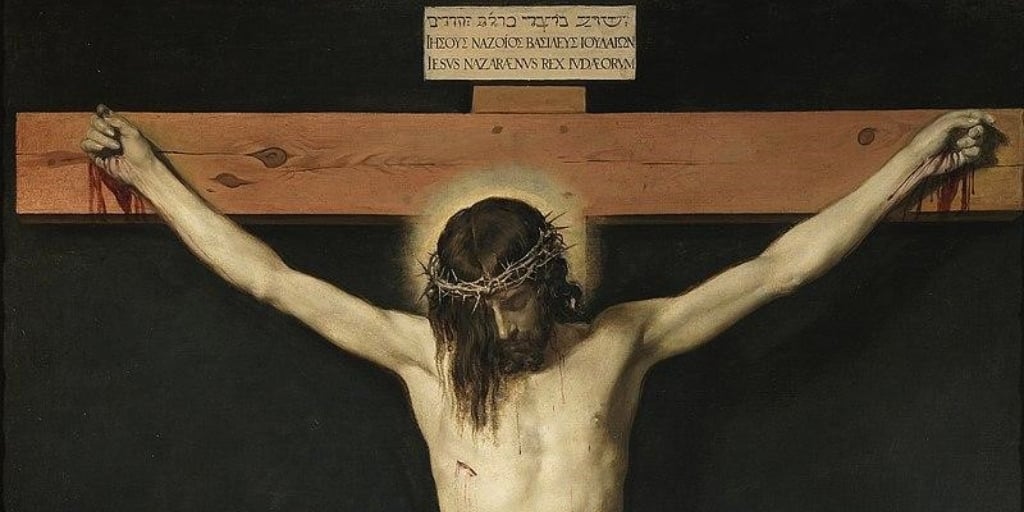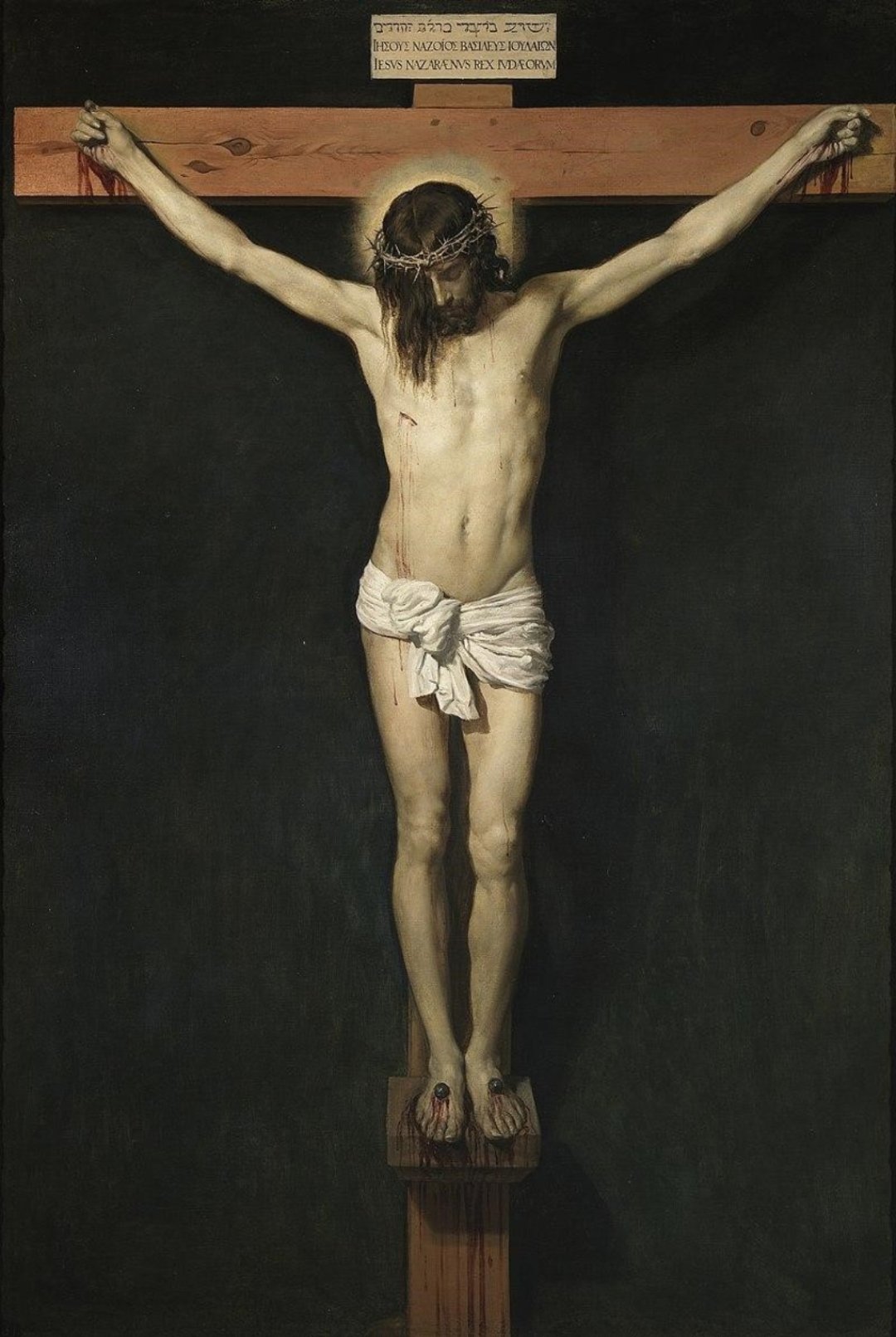
Kristin Romero describes how image of Christ crucified can continually inspire us to recognize Jesus in others.
While staying in Madrid, I had the opportunity to go to the Prado Museum, housing many of the world’s masterpieces of art. The only catch? I was there with my husband and four small children with just one hour to spend before we had to leave for the airport.
The Prado in an hour was an impossible task, especially with children that could care less. I began with a pep talk to kids (aged 3,6,9 and 11) “We're going to walk through this very fast. If I see something important, we'll stop at that one for a minute—then keep walking. So pay attention!” I’m sure they were looking at me like I was crazy. With a restriction on all pictures and video, we couldn’t even document all that we were missing!
With the spirit of “speed touring” (I’m coining the phrase), we walked into the 235,000-square feet museum to the overwhelming smell of oil paint. Immediately, we set off on our amazing race. We dodged from alcove to alcove, down long halls, past religious and secular art all mixed together from various times through the 11th – 18th centuries.
Meanwhile, my three-year-old was crying every time we had to move on from any image with a baby Jesus, lamenting that she wanted to see baby Jesus again, and again. Thankfully there were quite a few of those so I was able to satisfy her little tiny heart about every five minutes.
We had no idea what images we were going to find or what their backstory was. The only remarks shared were how realistic some looked, how weird others were, and so many nude statues that my son started counting all the “naked men.” He ended with 10 (his number, not mine).
As we hit 45 minutes, the little duckling line of children began to grumble about when this would end. It was at that time, toward the end of our limited one-hour speed tour that I turned a corner and came face to face with Christ Crucified by the Spanish 17th-century painter Diego Velázquez.

It stopped me. I gazed up at the 8-foot tall realistic portrait of Christ on the cross and was dumbstruck. There were so many religious pieces in the museum, so many images of Christ on the cross, but this one … this one gutted me.
It was so realistic. Jesus looked so human. Unlike other images, there is nothing around him. He’s naked, bleeding, and alone. There’s no crucifixion story playing out around Him. It’s just Jesus, dying.
Given I had very little time for reflection and a three-year-old yanking on my arm, God poured into me an hour’s worth of pondering and conversation in a matter of milliseconds.
“You look so human.”
“Yes,” He said.
“You look just like a man, a man dying. I don’t sense Your divinity.”
“Yes,” He continued, “because when you can see Me as a man, you are able to recognize Me in others.”
Then the verses from the Gospel of Matthew were placed in my mind:
For I was hungry and you gave me food, I was thirsty and you gave me drink, a stranger and you welcomed me, naked and you clothed me, ill and you cared for me, in prison and you visited me. (Matthew 25:35-36)
I had studied so much of St. Francis of Assisi’s life previously that I could feel in that moment the Lord pointing to the great Italian saint, showing me how he understood this Scripture passage, and how he understood this image. St. Francis fully embraced the crucified Christ as he wept before a different version of that image at San Damiano.
When we really accept the image of the crucified Christ, a man, whipped, bleeding, dying, alone, helpless, we better recognize that same need in others. In that image, we see our responsibility as Christians to aid our fellow man as Christ explains in Matthew 25:35-36. Those that do are the ones blessed by the Father. They are the ones who are welcomed into the kingdom of heaven (Matthew 25:34)
The crucified Christ, an image of victory over sin, is very much also a reminder of Christ’s humanity, the same humanity that He calls us to serve.
I’m a convert to Catholicism. So I grew up in Protestant churches with bare crosses. There are so many reasons why this has happened over the centuries but without getting too much into theology, I lament that bare crosses can lead to us losing sight of the humanity of Christ.
When we view bare crosses, indeed, it reminds us that He lives! But when we view Christ dying on the cross, as Diego Velázquez depicts him in that 8-foot-tall lifelike canvas, we are left challenged.
If we don’t let ourselves give into viewing the fully human side of our Savior, we struggle to recognize Him around us in others. Seeing Him in the broken, the hurting, the alone, the abused, in those that struggle under the ugly painful sin that needs His saving grace, the sin He bears in that crucified image.
All this flooded to me in those milliseconds. All this that the great saints deeply understood. Men like St. Francis who said,
As pilgrims and strangers in this world serving the Lord in poverty and humility, let [the Friars Minor] go seeking alms with confidence, and they should not be ashamed because, for our sake, our Lord made Himself poor in this world.
I look at that image online today and it simply does not do the 8 x 5.5-foot oil painting portrait justice. Viewing the picture online I’m drawn to his nakedness as a novelty. In person, however, I was drawn to all the blood, His wounds, His face hanging down to the ground, His helplessness, His dying, Him speaking to me to help the dying—the spiritually dying.
As my little three-year-old tugged on my hand one more time to find another painting with the baby Jesus, I looked at her little face and was captivated by her innocence. Baby Jesus was the portrait of our Lord that she needed to see, that she connected to. In my adulthood, at this time in my life, I needed to be convicted by Diego Velázquez’s Christ Crucified and Matthew 25:35-36.
The image of the crucified Christ keeps us Christian. Anyone can marvel at the divinity of Jesus, His miracles, and His ascension. The crowds in His time loved that too. But to gaze upon and accept the humanity in his death, very few were there to witness that. Sadly, I think we see very few accepting that now when they see it in the hungry, the strangers, or the ill (even the mentally ill).
So, we as Christians must stand among the few. We must let the image of Christ crucified continually inspire us to recognize Jesus in others that need him through us. We must let him work through us to the hungry, the thirsty, the stranger, the naked, the sick, the imprisoned—to be Christians in our world.
Copyright 2022 Kristina Romero
Images: Diego Velazquez, CC0, via Wikimedia Commons
 About the author: Kristina Romero is the creator of The Hagios Study, a series of Bible studies with a companion mobile app that explores scripture through the eyes of a Saint. Kristina has spent her entire career in the creative world, 10 years in Hollywood and 12 years in the web design industry running her own web business. She holds a Masters in Professional Writing from the University of Southern California and a Certificate of Theology in Church History from the University of Notre Dame. Kristina, her husband, and four children currently live outside Phoenix, Arizona. Follow her on Instagram at @hagios.study.
About the author: Kristina Romero is the creator of The Hagios Study, a series of Bible studies with a companion mobile app that explores scripture through the eyes of a Saint. Kristina has spent her entire career in the creative world, 10 years in Hollywood and 12 years in the web design industry running her own web business. She holds a Masters in Professional Writing from the University of Southern California and a Certificate of Theology in Church History from the University of Notre Dame. Kristina, her husband, and four children currently live outside Phoenix, Arizona. Follow her on Instagram at @hagios.study.
About the Author

Guest
We welcome guest contributors who graciously volunteer their writing for our readers. Please support our guest writers by visiting their sites, purchasing their work, and leaving comments to thank them for sharing their gifts here on CatholicMom.com. To inquire about serving as a guest contributor, contact editor@CatholicMom.com.


.png?width=1806&height=731&name=CatholicMom_hcfm_logo1_pos_871c_2728c%20(002).png)
Comments